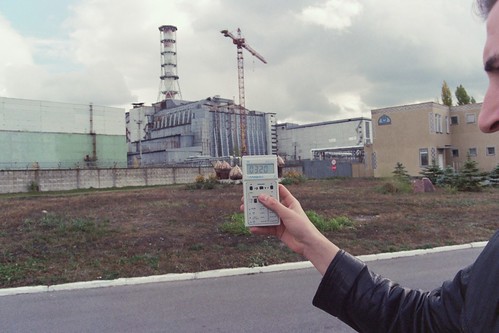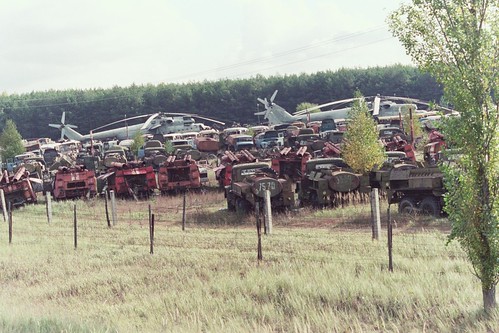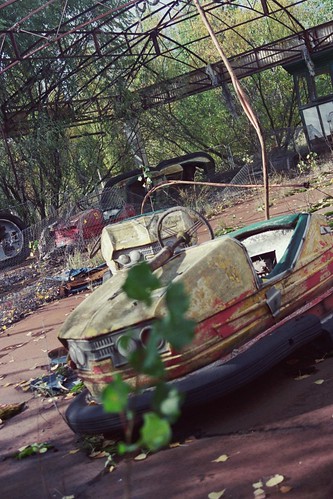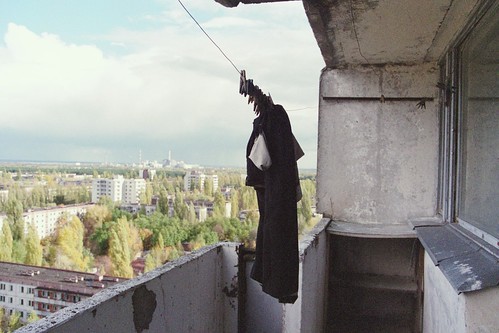Sunday, February 05, 2006
Go Nuclear -- Rerun
Since nothing interesting seems to happen in Ukraine -- at least now that I'm here -- I am going to move into re-runs. Gadling has been posting about Chernobyl tours, which inspired me. When the Producer and I traveled around the world in 2003, we stopped in Kyiv for a few weeks to visit a friend. During our visit, we toured Chernobyl. This is what I wrote about it.
Go Nuclear
The former Soviet Union is rife with environmental catastrophes that have been hidden from prying eyes from decades. There are so many, in fact, that it may be time for the creation of another tourism category called, "Soviet Environmental Disasters--Greatest Hits."
Chernobyl is located just 70 miles north of Kiev and several local travel agencies offer tours. After spending a day wandering around the site of the world's worst industrial accident, I'm not sure I know any more about the mechanics of the catastrophe than I did before. I did, however, gain insight into the myths that have grown up around it. These reveal far more about the human side of the disaster than the facts anyway.
During Soviet times, the ground was always plowed and ready for rumor planting. The Chernobyl seeds were sown early in the morning on April 26th, 1986. In the intervening 17 years, myths about the disaster have taken root deep in the toxic soil. These "truths" seem to serve a number of purposes. In the days and months following the accident, they filled the information vacuum. Now, they promote the idea of Ukrainian impotence in the face of overwhelming Soviet power and fuel the fires of animosity between Ukrainians and Russians.
They also provide cover. In some cases, the truth is too awful to articulate.
We visited on a shiny fall day. Peasants were finishing up their harvest and old women in headscarves sold baskets of fresh mushrooms and apples alongside the road. As we neared the reactor, no dead trees, multi-headed deer or scorched earth provided physical evidence of what had happened. In fact, the vegetation was particularly lush and animal life abundant, both free to thrive without human interference.
In the six hours or so we spent in the zones, we received less radiation than from the average X-ray, or so they say. Still, visitors are instructed not to touch anything, just to be safe.

Geiger reading in front of the infamous Reactor #4
Rimma, our official guide, carried a Geiger counter, which would shut itself off at the point at which radiation levels became too high for safety. It never reached that point and it was a fun toy to have along. It was useful for conducting spot checks of radiation levels in buildings, on vegetation and on local dogs.
The first stop in the outer zone was the "Equipment Cemetery." Neat rows of hundreds and hundreds of buses, trucks, military helicopters, private cars and ambulances rust in the field where they were abandoned. These vehicles were contaminated, but not so badly that they needed to be buried like hundreds of others.

Vehicle graveyard
Chernobyl may be the name most associated with the disaster, but the city most affected by it was the town nearest the reactor, Prypiat. Prypiat lies within the Inner Zone, which includes the 10 kilometers closest to the reactor. No one lives in the Inner Zone. In fact, all villages within the Inner Zone were bulldozed and buried. The only evidence of their existence is their road signs, which hang from the ceiling of the Chernobyl Museum in Kiev.
Built specifically to house plant workers, Prypiat was a young city designed in high Soviet style -- tall grey apartment blocks, wide boulevards, a culture house, ferris wheel, hotel and restaurant. Now, it's a ghost town, left exactly as it was when its residents fled in a big hurry. It's like a little time capsule of mid-80’s life in the Soviet Union, lacking any of the billboards, cafes and consumer culture that are now part of the landscape of every other city in the former Soviet Union. Its kindergarten was strewn with pages from "Uncle Lenin" picture books. Prypiat will probably continue to decay until someone has the money to bulldoze it. Or turn it into a theme park.

Prypiat Amusement Park
The most compelling rumors are those that made the Soviets look most craven. One of the more persistent is that families of high ranking local party officials were evacuated immediately after the fire started, at around 2:00 am on the morning of April 26. Rimma said it was impossible to know for sure if this really happened, but again, it's a plausible scenario and confirms the perception that in Soviet society, some people were more equal than others.
Evacuation of the rest of Prypiat’s 50,000 residents wasn’t complete until the evening of April 28th. Residents were allowed to take only one suitcase with them. It's now possible to explore their looted apartments, none of which have any refrigerators. Rimma said that because folks had stocked up on food in anticipation of the upcoming holiday, crews had to come in and remove the refrigerators to prevent an epidemic. She didn't know where the refrigerators are now.

Laundry on the line in Prypiat
The cause of the accident is shrouded in mystery and thus, a prime breeding ground for rumor. The truth is entombed in the concrete sarcophagus, but for some, the date of the accident provides important clues to its cause. Reactor workers report being under pressure from high officials to demonstrate above-average power output prior to May 1, the day when the accomplishments of "the workers" and glories of the Communist party were celebrated. The reactor and its turbines were pushed beyond their capacity, resulting in the fire that destroyed the reactor and released the radiation.
The truth may never be known.
It's also impossible to know how many people died as a direct result of the accident. There's a moving memorial to the firefighters who were the first on the scene, funded and built by their comrades. Its plaque reads, “to those who saved the world.” Only one of the first responders is still alive. His longevity is attributed to the fact that he had been at a wedding the night of the accident and arrived at the fire drunk on red wine and vodka. This confirms what every Russian or Ukrainian knows --that alcohol is armor and protects against every ill, even radiation poisoning.
Rimma said the death count could be in the hundreds of thousands – possibly millions. Official counts put the number of immediate deaths at 31.
Six hundred fifty thousand “liquidators” worked at the site in the months after the disaster. What compelled this army of workers to toil at the scene, putting themselves at huge risk of radiation exposure? Rimma attributed it to Soviets' deep-seated commitment to defend the motherland."If your mother needs your help," she explained, "you do what you must." Government propaganda played into this sentiment. "The Power of the Soviet People Is Greater than the Atom" read an enormous banner hung at the reactor site.
Unfortunately, the tour was very clinical. We didn’t have the chance to talk to anyone who had been directly affected by the disaster. By placing the disaster in the category of “history,” rather than an ongoing catastrophe that will affect generations to come, the tour diminished the tragedy of Chernobyl. This, too, may prove to be another convenient coping strategy for the Ukrainians who want to put the past behind them as quickly as possible.
Near the end of the tour, our small group stood on a railway bridge, throwing bread to catfish that live in the cooling pond next to the reactor. One monster, approximately seven feet long, surfaced and snatched half a loaf before disappearing into the dark water. "That's a normal size for catfish," Rimma said quickly.
Unverifiable. But plausible? Maybe.
Go Nuclear
The former Soviet Union is rife with environmental catastrophes that have been hidden from prying eyes from decades. There are so many, in fact, that it may be time for the creation of another tourism category called, "Soviet Environmental Disasters--Greatest Hits."
Chernobyl is located just 70 miles north of Kiev and several local travel agencies offer tours. After spending a day wandering around the site of the world's worst industrial accident, I'm not sure I know any more about the mechanics of the catastrophe than I did before. I did, however, gain insight into the myths that have grown up around it. These reveal far more about the human side of the disaster than the facts anyway.
During Soviet times, the ground was always plowed and ready for rumor planting. The Chernobyl seeds were sown early in the morning on April 26th, 1986. In the intervening 17 years, myths about the disaster have taken root deep in the toxic soil. These "truths" seem to serve a number of purposes. In the days and months following the accident, they filled the information vacuum. Now, they promote the idea of Ukrainian impotence in the face of overwhelming Soviet power and fuel the fires of animosity between Ukrainians and Russians.
They also provide cover. In some cases, the truth is too awful to articulate.
We visited on a shiny fall day. Peasants were finishing up their harvest and old women in headscarves sold baskets of fresh mushrooms and apples alongside the road. As we neared the reactor, no dead trees, multi-headed deer or scorched earth provided physical evidence of what had happened. In fact, the vegetation was particularly lush and animal life abundant, both free to thrive without human interference.
In the six hours or so we spent in the zones, we received less radiation than from the average X-ray, or so they say. Still, visitors are instructed not to touch anything, just to be safe.

Geiger reading in front of the infamous Reactor #4
Rimma, our official guide, carried a Geiger counter, which would shut itself off at the point at which radiation levels became too high for safety. It never reached that point and it was a fun toy to have along. It was useful for conducting spot checks of radiation levels in buildings, on vegetation and on local dogs.
The first stop in the outer zone was the "Equipment Cemetery." Neat rows of hundreds and hundreds of buses, trucks, military helicopters, private cars and ambulances rust in the field where they were abandoned. These vehicles were contaminated, but not so badly that they needed to be buried like hundreds of others.

Vehicle graveyard
Chernobyl may be the name most associated with the disaster, but the city most affected by it was the town nearest the reactor, Prypiat. Prypiat lies within the Inner Zone, which includes the 10 kilometers closest to the reactor. No one lives in the Inner Zone. In fact, all villages within the Inner Zone were bulldozed and buried. The only evidence of their existence is their road signs, which hang from the ceiling of the Chernobyl Museum in Kiev.
Built specifically to house plant workers, Prypiat was a young city designed in high Soviet style -- tall grey apartment blocks, wide boulevards, a culture house, ferris wheel, hotel and restaurant. Now, it's a ghost town, left exactly as it was when its residents fled in a big hurry. It's like a little time capsule of mid-80’s life in the Soviet Union, lacking any of the billboards, cafes and consumer culture that are now part of the landscape of every other city in the former Soviet Union. Its kindergarten was strewn with pages from "Uncle Lenin" picture books. Prypiat will probably continue to decay until someone has the money to bulldoze it. Or turn it into a theme park.

Prypiat Amusement Park
The most compelling rumors are those that made the Soviets look most craven. One of the more persistent is that families of high ranking local party officials were evacuated immediately after the fire started, at around 2:00 am on the morning of April 26. Rimma said it was impossible to know for sure if this really happened, but again, it's a plausible scenario and confirms the perception that in Soviet society, some people were more equal than others.
Evacuation of the rest of Prypiat’s 50,000 residents wasn’t complete until the evening of April 28th. Residents were allowed to take only one suitcase with them. It's now possible to explore their looted apartments, none of which have any refrigerators. Rimma said that because folks had stocked up on food in anticipation of the upcoming holiday, crews had to come in and remove the refrigerators to prevent an epidemic. She didn't know where the refrigerators are now.

Laundry on the line in Prypiat
The cause of the accident is shrouded in mystery and thus, a prime breeding ground for rumor. The truth is entombed in the concrete sarcophagus, but for some, the date of the accident provides important clues to its cause. Reactor workers report being under pressure from high officials to demonstrate above-average power output prior to May 1, the day when the accomplishments of "the workers" and glories of the Communist party were celebrated. The reactor and its turbines were pushed beyond their capacity, resulting in the fire that destroyed the reactor and released the radiation.
The truth may never be known.
It's also impossible to know how many people died as a direct result of the accident. There's a moving memorial to the firefighters who were the first on the scene, funded and built by their comrades. Its plaque reads, “to those who saved the world.” Only one of the first responders is still alive. His longevity is attributed to the fact that he had been at a wedding the night of the accident and arrived at the fire drunk on red wine and vodka. This confirms what every Russian or Ukrainian knows --that alcohol is armor and protects against every ill, even radiation poisoning.
Rimma said the death count could be in the hundreds of thousands – possibly millions. Official counts put the number of immediate deaths at 31.
Six hundred fifty thousand “liquidators” worked at the site in the months after the disaster. What compelled this army of workers to toil at the scene, putting themselves at huge risk of radiation exposure? Rimma attributed it to Soviets' deep-seated commitment to defend the motherland."If your mother needs your help," she explained, "you do what you must." Government propaganda played into this sentiment. "The Power of the Soviet People Is Greater than the Atom" read an enormous banner hung at the reactor site.
Unfortunately, the tour was very clinical. We didn’t have the chance to talk to anyone who had been directly affected by the disaster. By placing the disaster in the category of “history,” rather than an ongoing catastrophe that will affect generations to come, the tour diminished the tragedy of Chernobyl. This, too, may prove to be another convenient coping strategy for the Ukrainians who want to put the past behind them as quickly as possible.
Near the end of the tour, our small group stood on a railway bridge, throwing bread to catfish that live in the cooling pond next to the reactor. One monster, approximately seven feet long, surfaced and snatched half a loaf before disappearing into the dark water. "That's a normal size for catfish," Rimma said quickly.
Unverifiable. But plausible? Maybe.



